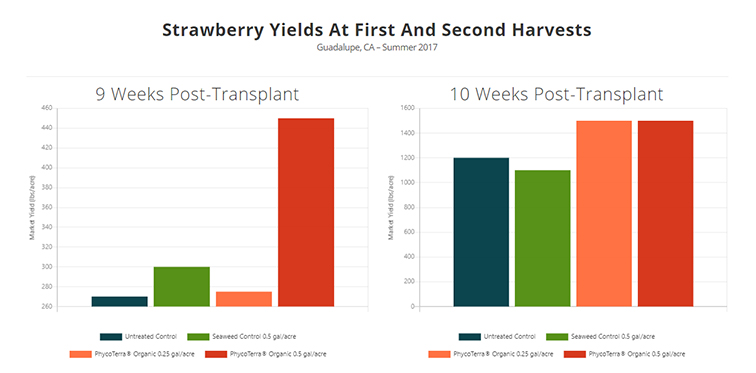Don’t Let Blueberry Irrigation Problems Bury You
Just like all other crops, blueberry has its own water consumption requirements that vary with the age of the crop (until full maturity), age of the pine bark mulch, season, and time of the day. The highest water consumption occurs during the summer. During the course of the day, the highest consumption depends on the prevailing weather conditions. On a normal day, that takes place around midday. Even on a cooler day, water consumption levels can increase under windy and low humidity conditions. Usually, water consumption levels are negligible during nights.
The soil should possess the capacity to store adequate amount of water so that it can be released as crop demands. Sandy soils in Central Florida Ridge area do not have the necessary storage capacity. When pine bark is added to the soil, the situation becomes rather complex. Pine bark pieces are hundreds of times larger than the average soil particles, and the air spaces between these pieces are too large to hold water against the gravitational force. Thus, the drainage rate of water increases three to six times when pine bark is present. The blueberry root system more or less confines to the pine bark amended layer, which is about 8 to 12 inches and therefore, it takes less than 10 minutes to drain over-irrigated water below the active rootzone.
Rainfall records from Central Florida indicate the total rainfall during a year is roughly 50 inches. Also, estimates indicate the total water demanded by a crop is about 50 inches. Since the rainfall is not conveniently distributed through the year, the need for irrigation arises.
In a study conducted at two farms, we estimated that the total water used on the fields were about five to eight times higher than what the blueberry crop requires. Using soil water sensors, we monitored the number of irrigation pulses per day (see Table 1) and the water content of the soil before each irrigation pulse (see Table 2).
Table 1: Number Of Irrigation Pulses Per Day In The Two Farms
| Number of irrigation pulses/day | Pulse duration | |
| Farm A | 4 to 6 | 12 minutes |
| Farm C | 2 tp 4 | 20 minutes |
Table 2: Soil Water Status At Different Soil Layers Just Before Initiation Of The Irrigation Pulse
|
Soil Water Content |
|||
| Soil Depth | Soil Material | Before irrigation |
Field Capacity |
|
cm |
% |
||
| 0 to 7.5 | Pinebark |
25 |
24 |
| 7.5 to 15 | Pinebark+Soil |
22 |
20 |
| 15 to 30 | Sand+Organic matter |
13 |
12 |
| 0 to 30 (mean) |
20 |
19 |
|
| 30 to 60 | Sand |
7 |
10 |
The first irrigation on any particular day was started with soil water content below the storage capacity. However, during subsequent irrigation pulses, the soil water content was above the storage capacity and therefore, the water from the resulting irrigation is likely drained below the rootzone.
Let’s assume that the water consumed by the crop is equal to one unit per year. Then, if we break down the water received by the field into separate units (see Table 3), water need vs. actual water output can be determined.
Table 3: Assuming water required by blueberry is 1 unit, the number of units for a) rainfall, b) freeze protection, c) crop use, d) total received by the field, and e) excess supplied in irrigations are:
| Irrigation | Water from | Water for freeze | Water demanded | Total received | Excess |
| Method | Rainfall (a) | Protection (b) | By blueberry (c) | In the field (d) | Water (e) |
| Drip | 1 | 1 | 1 | 5 | 3 |
| Microsprinklers | 1 | 1 | 1 | 8 | 6 |
Therefore, water not used by blueberry plants amounts to about three times the crop requirement when irrigated with drip and six times when irrigated with microsprinklers.
Editor’s note: The author would like to acknowledge Southwest Florida Water Management District for funding and thank grower cooperators Jerry Mixon and William Futch for access to their farms for the purpose of this research.
Possible Ways To Cut Down Excessive Irrigation
In Florida, about 90% of the drinking water comes from groundwater. Reducing excessive
irrigations will help reduce agrichemicals leaching below rootzone while saving energy.
The question is how to reduce excess irrigations?
- Track the soil water content between irrigations and rainfall. There are different methods to do that; and using soil water sensors is a convenient method.
- Maximize the effectiveness of rain water.
- Reduce the number of irrigation pulses per day.
- Reduce irrigation frequency and increase the length of each pulse from the first pine bark addition to the next as pine bark degrades.
- Reduce number of irrigation pulses on cloudy, cool days.
- Give maximum effort to avoid irrigation on rainy days while allowing adequate time to start the next irrigation after a rainfall.
- During certain growth stages, plants can perform well with less water.
- If the blueberry field has a restricted drainage layer, reduce irrigation if the subsoil below the rootzone is saturated.
Other Methods That Need To Be Tested
- Explore the efficiency of alternate methods available for freeze protection.
- Continue to improve plants’ ability to perform well with less irrigation.
- Find alternate organic substrates that can replace pine bark.









